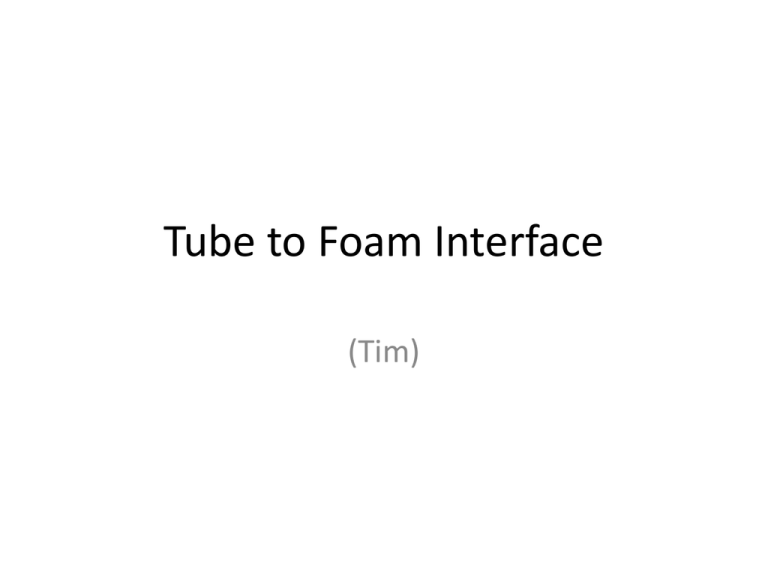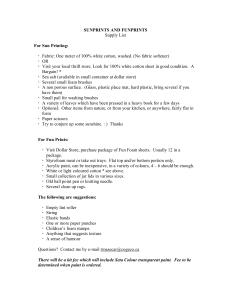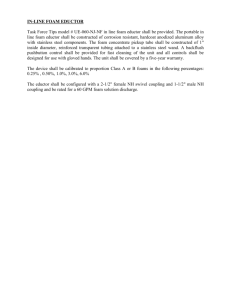Tube to Foam Interface
advertisement

Tube to Foam Interface (Tim) Outline • Discuss what’s known about the tube to foam interface – Describe problem – Issues – Theoretical Calculations – Anecdotal Experience 30/05/2012 Tube to Foam Interface 2 Problem • Heat Flow – – • The heat generated within the active components on a stave is removed through evaporating CO2 in smallbore tubes. The heat is conducted from the facesheets to the tube via thermally-conducting carbon foam and two interfaces made using thermally-conducting adhesive. Geometry – Tubes (S/steel so far) • – For the future • – 2.2mm OD x 0.14mm wall (ABCN130) Thermally-conducting Foam • • • 1/8” (3.175mm) OD x (0.50, 0.25, 0.22mm wall) Strip-staves: Pixels: Two 10mm wide ‘bars’ Full width ‘slabs’ Materials – Tubes • • – Thermally-conducting foam • • – Pocofoam Allcomp foam Tube-to-foam adhesives • • 30/05/2012 316L / 304L stainless steel (current staves & stavelets) CP2 titanium (only used in UK ‘nearly glue-less’ stavelet CGL (compliant) Hysol EA9396 (30% BN by wt) (rigid) Tube to Foam Interface 3 Issues / Concerns • Thermal Performance – Is the thermal impedance of the tube-foam interface good enough to mitigate against thermal runaway • Stave Mechanical Stability – Are the temperature-induced stave deformations (and associated stresses) small enough (stable enough) to ensure good tracking performance. • Longevity – Will the thermal impedance of the joint deteriorate over time? – Could stresses induce creep 30/05/2012 Tube to Foam Interface 4 Comparison Rigid Adhesive Compliant Adhesive • Could the adhesive ‘slump’? i.e. separate out under – Gravity – Capillary flow • Could the adhesive ‘migrate’ away from the interface? – Closed Cell foams – Open Cell foams • Could the adhesive become less compliant? – Irradiation induced ‘curing’ may produce a ‘rigid’ joint over time. 30/05/2012 • Could thermally-induced stresses lead to:– Large dimensional changes – High stresses which might promote cracking & ultimate failure of thermal path • Could the need to accommodate dimensional changes complicate stave mounting? – Fixations in Z – Mounting brackets • What are the effects of longterm creep? Tube to Foam Interface 5 Open and Closed-cell Foams • Allcomp Foam – Open structure from low density (0.05g/cc) open cell foam – 100-130ppi (0.25mm) • Pocofoam – Closed cell structure with voids typically 0.5mm diameter – Voids volume equivalent to 0.22mm thick glue layer 30/05/2012 Tube to Foam Interface 6 Thermal Properties Approximate Power Headroom Factor wrt 0.65mW/mm 2(0C) 1 2 4 6 8 10 12 Sensor Glue => IRS2125, 0.44W/m K ALL Ks halved Fluid htc (=>4000) Foam Glue (BN/Hysol) CFRP Kx Cable Bus Ky CFRP Ky Foam Kxyz Baseline 0 1 2 3 4 5 6 7 8 9 10 11 12 13 14 15 16 Coolant Temperature Headroom wrt -30C [C] 17 18 19 20 21 22 23 24 • Second largest impact (after fluid htc) • Doubling the thermal impedance of the foam glue reduces the coolant temperature headroom by 2⁰C (≈ 10%) 30/05/2012 Tube to Foam Interface 7 Stave CTE Assuming Rigid Foam & Rigid Glue • Simple 1D model (Classical Laminate Theory) – 2 Face sheets (all 0/90/0) • K13D2U / RS-3 • K13C2U / EX-1515 • K13C2U / EX-1515 [80gsm/29%RC] [100gsm/40%RC] [45gsm/40%RC] – 2 Cooling tubes • S/Steel: • Titanium: 3.185mm OD x 0.22mm wall (x2) Effective thickness 0.037mm 2.2mm OD x 0.14mm wall (x2) Effective thickness 0.017mm – 2 Bus Tapes • 0.025mm Kapton cover-layer • 0.025mm / 0.05mm Aluminium screen • 0.100mm Kapton 30/05/2012 Tube to Foam Interface 8 30/05/2012 -1.5E-06 Bare Facesheets Facesheets + S/S Tube Facesheets + Ti Tube Facesheets + Tape (50) Tube to Foam Interface Facesheets + Tape (25) Facesheets + Tape(50) + S/S Tube Facesheets + Tape(50) + Ti Tube Facesheets + Tape(25) + S/S Tube K13C2U[45gsm/40%RC][]s(0.025)+Ti K13C2U[100gsm/40%RC][]s(0.025)+Ti K13D2U[80gsm/29%RC][]s(0.025)+Ti K13C2U[45gsm/40%RC][]s(0.025)+SS K13C2U[100gsm/40%RC][]s(0.025)+SS K13D2U[80gsm/29%RC][]s(0.025)+SS K13C2U[45gsm/40%RC][]s(0.05)+Ti K13C2U[100gsm/40%RC][]s(0.05)+Ti K13D2U[80gsm/29%RC][]s(0.05)+Ti K13C2U[45gsm/40%RC][]s(0.05)+SS K13C2U[100gsm/40%RC][s](0.05)+SS K13D2U[80gsm/29%RC][]s(0.05)+SS K13C2U[45gsm/40%RC][]s(0.025) K13C2U[100gsm/40%RC][]s with… K13D2U[80gsm/29%RC][]s with… K13C2U[45gsm/40%RC][tape/0/90/0]s K13C2U[100gsm/40%RC][tape/0/90/0]s K13D2U[80gsm/29%RC][tape/0/90/0]s K13C2U[45gsm/40%RC]0/90/0/Ti/0/90… K13C2U[100gsm/40%RC]0/90/0/Ti/0/9… K13D2U[80gsm/29%RC]0/90/0/Ti/0/90… K13C2U[45gsm/40%RC]0/90/0/SS/0/9… K13C2U[100gsm/40%RC]0/90/0/SS/0/… K13D2U[80gsm/29%RC]0/90/0/SS/0/9… K13C2U[45gsm/40%RC]0/90/0 K13C2U[100gsm/40%RC]0/90/0 K13D2U[80gsm/29%RC]0/90/0 Stave 1D Model CTE Stave CTE Assuming Rigid Foam & Rigid Glue 3.0E-06 2.5E-06 2.0E-06 1.5E-06 1.0E-06 5.0E-07 0.0E+00 -5.0E-07 -1.0E-06 Facesheets + Tape(25) 9+ Ti Tube Historical Data • Jones (2009) – Crude measurement of relative CTE of CLG & Rigid epoxy – Measurement of thermal performance vs Thermal cycling (15 cycles) • Sutcliffe (2010) – Stavelet FEA • LBNL (2010) – Thermal Cycling of 12cm rigid-glued prototypes 30/05/2012 Tube to Foam Interface 10 – CGL – ER2074 (rigid epoxy) • Zero thickness glue line • 0.1mm glue line ER2074(0.0) ER2074(0.0) ER2074(0.1) CGL % strain 0.0233 0.0242 0.0187 0.0091 CTE (ppm) 4.57 4.75 3.67 1.78 40 0.035 30 0.03 20 0.025 10 0.02 0 0.015 -10 0.01 -20 0.005 -30 0 ER2074 '0' -0.005 Stave Temperature -40 -0.01 -50 0 60 120 180 240 300 360 420 360 420 480 540 600 Time (s) 0.04 ER2074 (0.0mm) ER2074 (0.0mm) ER2074 (0.1mm) 0.035 0.03 Thermal Strain(%) • Cool down to -40C and allow to rise back to room temperature 0.04 0.025 0.02 0.015 0.01 0.005 0 -0.005 -0.01 0 30/05/2012 60 Tube to Foam Interface 120 180 240 300 Time (s) 480 540 600 11 Temperature (deg C) • Clip-type extensometer • 30cm prototypes Thermal Strain (%) Jones2009 Jones2009 • 30cm single-tube prototypes – Equivalent thermal performance for CGL and rigid epoxy – Thermal cycling shows no deterioration of average temperature above cooling tube at -40⁰C 30 Temperature (deg C) 20 10 0 -10 -20 -30 -40 -50 0 1 2 3 4 5 6 Time (h) 30/05/2012 Tube to Foam Interface 12 Sutcliffe (2010) • Standard UK build – 0/90/0 K13D2U/RS3 (80gsm,29%RC) – 1/8” s/steel tubes • CTEs – No Al screen • 0.02mm contraction • CTE = 1e-6 – 0.05mm Al screen • 0.042mm contraction • CTE = 2e-6 30/05/2012 Tube to Foam Interface 13 Critical Stresses • Foam stress (likely) to cause failure – but structures survive! • Two explanations – Glue bridging between facesheet and tube – Simple FEA assumes linear material properties but materials testing reveals otherwise • UK Stave core design employs end closeouts to protect foam 30/05/2012 Tube to Foam Interface 14 Mechanical Materials Measurements • Pocofoam has different properties in orthogonal directions and a failure stress of typically 0.8MPa 3.5 3 1 Tensile loading of foam 2 Unloading of foam Stress (MPa) 2.5 2 1.5 1 0.5 Failure • Allcomp (K9) – 130ppi has uniform characteristics and failure stress >2.5MPa 1 2 0 30/05/2012 Strain Tube to Foam Interface 15 LBNL (2010) • Construction – Length 12cm – Hysol 9396/BN(30% by weight) to bond tube & facings to foam – K7 foam – One SS tube(2.8mm OD) – One Ti tube(2.2 mm OD) • Thermal cycle and irradiation(time sequence) – – – – • 900 cycles (20C<->-35C) then 1 cycle to -70C then 1 cycle to about -175C with LN2 then Irradiation to 50 MRad, then to 150 Mrad total No change in Thermal performance – No difference in SS and Ti tubes (with given ID/OD). Not a surprise (from FEA). – No significant change in thermal performance for any sample after any thermal cycle sequence, including LN2 – Effect of irradiation up to 1 GRad is <10% increase in T. – Thermal performance with K9 foam is significantly better than with K7 foam, by about 25% 30/05/2012 Tube to Foam Interface 16 30/05/2012 Tube to Foam Interface 17 30/05/2012 Tube to Foam Interface 18 LBNL/BNL (2012) Stave 1.3m x 0.12cm Stave 1.2m x 0.12m 0/90/0 250 um thick K13D2U facings, 80-100 gsm pre-preg Co-cured facings, low density 45 gsm cf pre-preg. 0/90/0 370 um thick K13C2U + bus facings CGL around s/steel pipe, Allcomp foam CGL around steel pipe, Allcomp foam area[cm^2] 1560 Co-cure Stave Component Weights Weight [grams] Pipe Foam CGL Facings CF Tubes Closeouts Hysol Honeycomb Weight [g] 106.3 45.6 15 104.8 38.7 4.2 30.7 24.7 Total 370 fitings 16.6 new total 30/05/2012 facing 1 facing 3 two cf tubes Stainless Steel Pipe+Fittings closeouts CGL on foam and pipe foam honeycomb hysol 30% BN facing #1 hysol 30% BN facing #3 84.7 84.6 18.3 76.1 3.4 15.3 50.4 25.3 15.6 16.8 Total Stave Weight 390.4 386.6 Tube to Foam Interface 19 Comparison of Stave Stiffness, Room Temp and Chilled Stave stiffness independent of temperature (simple support 120 cm apart) 30/05/2012 Stave is about 10% stiffer when chilled with -30 deg-C coolant. Bus cable glue layers responsible??? (simple support 120 cm apart) Tube to Foam Interface 20 Co-cure stave contraction 30/05/2012 Tube to Foam Interface 21 1.3 m stave and 1.2 m co-cure stave contraction • Stave Contractions – 1.2m co-cure stave contracts 0.2mm • CLT predicts 0.118mm assuming completely free tube • NB Stave is held together with 2 x 15g of Hysol – equivalent to 0.082mm thickness spread over stave area – 1.3 m stave expands ~ 20-35 um • CLT predicts 0.040mm assuming completely free tube • Similar glue mass / thickness • Tube Length Changes – Pipe moves into co-cure stave ~ 100 um, into 1.3 m stave ~ 160 um – Free stainless steel pipe should contract ~ 1mm when cooled ~ 50 deg-C – Question is: does pipe really contract 1 mm? If so, see analysis of 1.3 m stave on next slide 30/05/2012 Tube to Foam Interface 22 1.3 m stave contraction analysis But we expected pipe to be mostly fixed at U-bend 30/05/2012 Tube to Foam Interface 23 Summary & Conclusions • Stresses in staves come from – Bus tapes (primarily the aluminium screen) – Core assembly adhesive – Cooling tubes (if assembled with rigid epoxy) • Evolving stave design reduces potential stresses – Smaller bore tubes (ABCN130) – Titanium (Progress in joining technology) – Bus-tape screen (0.05mm -> 0.025mm -> ‘0’ ?) • CGL – Experience since 2008 • Many staves built showing good thermo-mechanical performance – Concerns about migration into foam structure addressed by lining channel with rigid epoxy – Reliance on ‘sliding’ properties over long service life in high radiation environment – Some evidence that tube is not completely ‘free’ • Rigid Adhesive (Hysol9396/30%BN) – Experience since 2009 – Thermal cycling (tens to many hundreds) • No failures for ‘nominal’ cycling (Room temp to -40C) – FEA shows stresses in all components (in particular the foam) have large safety margins for ‘nominal’ excursions and indicate that structures will survive large (160C) excursions. 30/05/2012 Tube to Foam Interface 24






